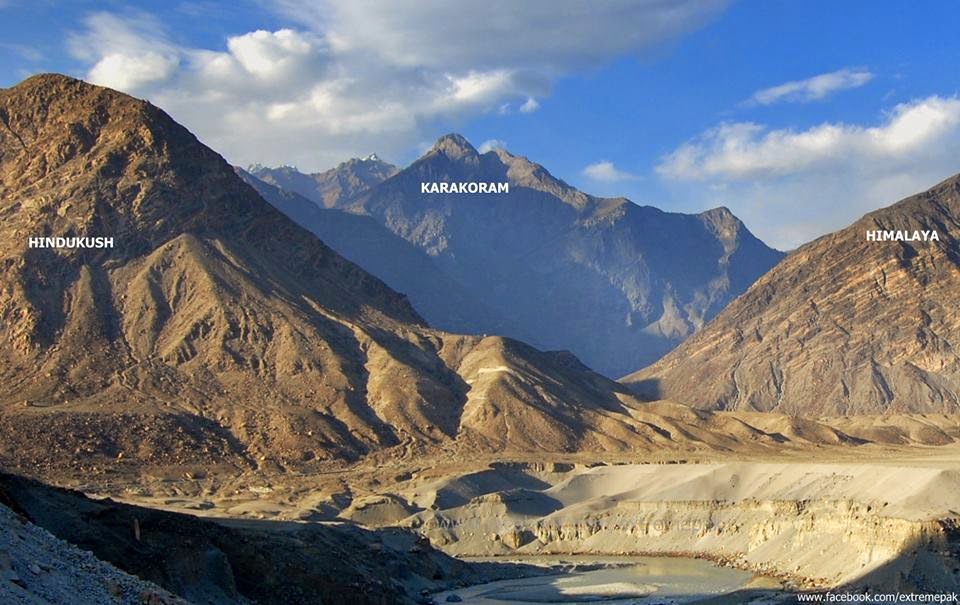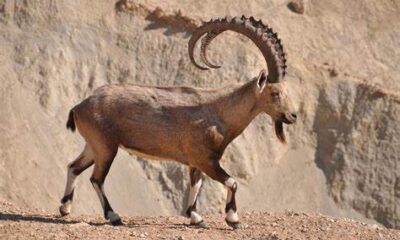Article
Junction Point of Three Mountain Ranges: The Confluence of the Himalayas, Karakoram, and Hindu Kush
Published
9 months agoon
By
EDITOR
One of the most geographically significant and awe-inspiring places on Earth lies in the northern region of Pakistan, where three of the world’s most iconic mountain ranges meet: the Himalayas, the Karakoram, and the Hindu Kush. This junction point, located near the city of Gilgit, is a rare and remarkable phenomenon, unmatched anywhere else in the world. The convergence of these mighty ranges has shaped the physical, cultural, and climatic landscape of the region, making it a globally significant site for mountaineers, geologists, and travelers alike.
The Great Mountain Ranges
- The Himalayas: Stretching over 2,400 kilometers across five countries, the Himalayas are the tallest mountain range in the world. Home to the planet’s highest peak, Mount Everest (8,848 meters), the Himalayas are a symbol of grandeur and natural beauty. In Pakistan, the westernmost end of the Himalayan range can be seen, which includes notable peaks such as Nanga Parbat (8,126 meters), the world’s ninth-highest mountain. Known as the “Killer Mountain,” Nanga Parbat is one of the most formidable challenges for mountaineers.
- The Karakoram Range: The Karakoram is arguably the most rugged and spectacular range, famed for its concentration of towering peaks. It contains K2 (8,611 meters), the second-highest mountain in the world and one of the most challenging climbs. The Karakoram range stretches over 500 kilometers and is home to some of the largest glaciers outside the polar regions, including the Baltoro Glacier and the Siachen Glacier. The Karakoram is known for its dramatic landscapes, with sharp ridges, ice-clad peaks, and deep valleys.
- The Hindu Kush: Extending from central Afghanistan to northern Pakistan, the Hindu Kush range is famous for its historical and geopolitical significance. It has acted as a natural barrier between Central Asia and South Asia for centuries, influencing the movement of peoples, cultures, and armies. The highest peak in the range is Tirich Mir (7,708 meters), located in Pakistan’s Chitral district. The Hindu Kush is known for its rugged terrain and steep passes, and its name is often translated as “Killer of the Hindus,” referencing the harsh conditions of the region.
The Unique Convergence
The junction point of these three colossal ranges is located near the Karakoram Highway (KKH), particularly at a place called Jaglot, just south of Gilgit city in Gilgit-Baltistan. This geographical marvel, often referred to as the “Triple Point”, is where the edges of the Himalayas, Karakoram, and Hindu Kush come together. The area is flanked by mighty peaks and offers stunning views of the ranges that diverge from this unique location, each heading off in different directions.
The Indus River flows nearby, further enhancing the dramatic natural beauty of the region. It cuts through these mountain ranges, acting as a lifeline for the people of Pakistan and feeding into the plains of Punjab and Sindh. The Indus River has its source in the Tibetan Plateau and journeys through these formidable mountains before entering Pakistan.
Geological Significance
The convergence of the Himalayas, Karakoram, and Hindu Kush is not only a breathtaking sight but also a point of great geological interest. This junction marks the collision of tectonic plates – the Indian Plate colliding with the Eurasian Plate. This tectonic activity is responsible for the creation of the Himalayan range and the continued growth of the mountains. The region remains seismically active, with earthquakes being a frequent occurrence.
The Karakoram and Hindu Kush ranges, though younger than the Himalayas in geological terms, are part of the same complex tectonic history. The ongoing tectonic forces continue to shape the landscape, giving rise to steep peaks, deep valleys, and massive glaciers.
Cultural and Historical Importance
The junction of these three ranges is not just a meeting point of mountains but also a crossroads of cultures. Historically, the region has been a part of ancient trade routes, including the famous Silk Road, which connected the East with the West. Traders, pilgrims, and conquerors have passed through these mountains, leaving behind a rich cultural legacy.
The indigenous people of the region, including Baltis, Shins, and Wakhis, have lived in the shadow of these mountains for centuries. Their cultures and traditions have been shaped by the harsh yet beautiful environment, with a deep connection to the land. The strategic importance of the region has also made it a point of interest for many empires throughout history, including the Mughals, British Empire, and modern-day powers.
Tourism and Mountaineering
The junction point of the Himalayas, Karakoram, and Hindu Kush has become a popular destination for adventurers, trekkers, and nature enthusiasts. The Karakoram Highway, often called the eighth wonder of the world, is one of the highest paved roads on the planet and offers access to this unique geographical feature. The highway, which follows the ancient Silk Road, attracts tourists seeking to experience the majestic landscapes and the rugged beauty of northern Pakistan.
Mountaineers are drawn to the region because of its concentration of some of the world’s highest and most challenging peaks. The Baltoro Glacier trek and expeditions to K2 and Nanga Parbat are among the most coveted adventures in the mountaineering world. The region is also home to beautiful valleys such as Hunza, Skardu, and Chitral, which offer stunning landscapes, ancient forts, and a glimpse into the unique cultures of the people living in this remote part of the world.
Environmental Concerns
While the region’s natural beauty and ruggedness are appealing, the area is also fragile and under threat from climate change. The glaciers of the Karakoram, Himalayas, and Hindu Kush are crucial sources of fresh water for millions of people in Pakistan and beyond, feeding major rivers like the Indus. However, these glaciers are now receding at an alarming rate due to rising global temperatures.
Efforts are being made to study and preserve the environment, but the challenges posed by climate change are significant. Sustainable tourism, environmental conservation, and responsible development are essential to ensuring that this unique region continues to thrive for future generations.
Conclusion
The junction point of the Himalayas, Karakoram, and Hindu Kush in northern Pakistan is a natural wonder of global significance. The convergence of these three mighty ranges represents the meeting of some of the most formidable and spectacular mountains in the world. Beyond its geographical and geological importance, the region is a cultural crossroads, a mountaineer’s paradise, and a crucial environmental zone.
As the “Roof of the World,” this part of Pakistan stands as a testament to the planet’s natural beauty and the enduring spirit of adventure that draws people to its towering peaks and vast landscapes.
You may like
-


Unity, Faith, and Discipline: The Cornerstones of Pakistan’s Motto as “Aik Qaum” (One Nation)
-


Aik Qaum: The Fusion of Integrity and Patriotism
-


“AIK QAUM” DECLARATION OF CONCEPTION
-


Dr. Abdul Qadeer Khan: The Real Hero of Pakistan
-


The Chiltan Ibex: A Rare Treasure of Balochistan
-


MANGO HEALTH BENEFITS NUTRITION
Article
Aik Qaum: The Fusion of Integrity and Patriotism
Published
3 weeks agoon
May 28, 2025By
EDITOR
We keep Integrity closest to our Heart and Patriotism on top of our mind.
Integrity and patriotism are not separate entities; they are intertwined in the soul of Pakistan. The people understand that to be a patriot is to uphold the principles of integrity. Honesty and love for one’s country are two sides of the same coin. Together, these values form the essence of “Aik Qaum.”
The fusion of integrity and patriotism is evident in the everyday lives of Pakistanis. It’s in the farmer toiling the fields, the teacher educating the youth, and the soldier guarding the borders. It’s in the child who dreams of a better Pakistan and the elderly who have seen the nation grow. “Aik Qaum” is the realization that integrity and patriotism are the heart and mind of Pakistan, beating in unison to guide the nation forward.
As we celebrate the spirit of “Aik Qaum,” we honor the values that make Pakistan a unique and resilient nation. Integrity and patriotism serve as our guiding stars, leading us towards a brighter and more prosperous future. In the heart of every Pakistani and at the forefront of their minds, “Aik Qaum” stands as a testament to the strength of a united nation, bound by the principles of integrity and the unyielding love for their homeland.
In Pakistan, “Aik Qaum” is not just a motto; it’s a way of life that embodies the enduring spirit of a proud and united nation.

Our Initiative
The fabric of the Pakistani nation has something unique in its knit, something signature and so sanguine that could keep on energizing its very fibers irrespective of the floods of considerably tough challenges posed against it since its inception. There is also a belief that Pakistan has been blessed with such a golden glitter that couldn’t be ignored by any sensible system of reason and knowledge among the league of free, upright and kind nations. The credit goes to the amazing people of Pakistan. It is more exciting to find that the people of Pakistan, be it the businessmen, doctors, parents, soldiers, students, teachers, judges, labourers or lawyers etc, have assumed the duty bestowed upon them by the founder of the nation, Quaid-e-Azam Muhammad Ali Jinnah decades ago. Quaid once said “If you will work in cooperation, forgetting the past, burying the hatchet, you are bound to succeed.” At another occasion, Quaid summed this message up in just three words: Unity, Faith and Discipline. AIKQAUM.COM is an initiative built upon the idea of translating this vision of the founder of Pakistan, Quaid-e-Azam Muhammad Ali Jinnah into a fruitful action.
There is no power on earth that could restrict us from finding those beautiful commonalities among the people of this beautiful nation. It contends to promote the psyche morale of the Pakistani nation by addressing the issues instead of dodging them. We have a team of thorough professionals fully equipped to create unique platforms, forums and projects which will bring people closer on all sensitive issues related to our national identity and progress. We also have a strong support network for successful execution of all our campaigns in order to induce greater cohesion and the spirit of coexistence across the length and breadth of Pakistan. Coincidentally, we are living through an age of increased morphing of warfare in a world that’s once again moving from unipolar to a multipolar turf. The social, political, economic and technological factors shaping the evolution of warfare are being constantly experimented and employed in our own region. In a time of increased friction between regional powers and a heightened threat on the eastern border, Pakistan faces multiple challenges posed at its internal, external and economic security.
All these factors, blended with our archrival’s constant image building campaigns, a heavily funded lobbying in the West, the new Indo-US strategic alliance, as well as India’s ambition to start a space race, puts our nation on caution and throws immense burden of responsibility on our shoulders. We are witnessing a rise of sub conventional warfare fought with guns and bombs, but won on keyboards and drawing boards. AIKQAUM.COM aspires to be a strong force of defense against the subversive forces that are trying to malign Pakistan and hurt our interests in the region. We are fully trained and equipped to meet the challenges on the social and digital front.
www.aikqaum.com, info@aikqaum.com
Our Philosophy
VISION:
To create a social awareness about the values which join our nation together while countering anti-Pakistan narratives with logical and practical rationale.
MISSION:
To infuse a sense urgency for cohesion among all ethnic, political and religious schools of thought.
VALUES:
We keep integrity closest to our heart and patriotism on top of our mind. Our work ethics and commitment to our people shall empower us to achieve success in all our pursuits.
Article
The Chiltan Ibex: A Rare Treasure of Balochistan
Published
2 months agoon
April 16, 2025By
EDITOR
The Chiltan ibex (Capra aegagrus chiltanensis), a subspecies of the wild goat, is one of the most unique and endangered animals native to Pakistan. Found exclusively in the rocky highlands of the Chiltan range within the Hazarganji-Chiltan National Park in Balochistan, this elusive animal represents the region’s rich biodiversity and ecological heritage.
Physical Characteristics
The Chiltan ibex is a strikingly beautiful species, with a robust, muscular build perfectly suited for navigating steep and rocky terrains. Males are particularly distinctive, boasting impressive curved horns that can grow up to 30 inches (76 cm) in length. Their coat is light brown, with a darker stripe running along their back and legs, providing excellent camouflage in their arid mountainous habitat.
Females are smaller in size with shorter, more slender horns, and their coloration is less pronounced, blending seamlessly into their surroundings. This camouflage helps protect them and their offspring from predators such as wolves and large birds of prey.
Habitat and Range
The Chiltan ibex inhabits the rugged, semi-arid regions of the Chiltan range, located within the Hazarganji-Chiltan National Park, southwest of Quetta. These high-altitude areas, ranging from 1,500 to 3,200 meters above sea level, are characterized by rocky cliffs, sparse vegetation, and extreme weather conditions.
The ibex is well-adapted to this challenging environment, where it feeds on grasses, shrubs, and the leaves of juniper trees. Its ability to climb steep slopes and jump across narrow ledges gives it a unique advantage in escaping predators and surviving in such inhospitable terrain.
Behavior and Social Structure
Chiltan ibexes are diurnal, meaning they are active during the day. They are typically found in small groups, with herds consisting of females and their young. Males are more solitary, joining herds only during the breeding season, which occurs in the late autumn and winter months.
During this time, males engage in dramatic displays of strength to compete for mating rights, including horn clashing and dominance rituals. After a gestation period of around six months, females give birth to one or two kids in spring, when food availability is higher.
Conservation Status
The Chiltan ibex is classified as endangered due to its restricted range, habitat loss, and poaching. Habitat degradation caused by overgrazing, deforestation, and human encroachment poses significant threats to its survival.
Historically, the ibex faced heavy hunting pressure for its horns, considered a symbol of prestige, and for its meat. Although hunting is now banned in the national park, illegal poaching remains a concern.
Conservation Efforts
To protect the Chiltan ibex and its fragile ecosystem, the Hazarganji-Chiltan National Park was established in 1980. Spanning over 32,500 acres, the park provides a safe haven for the ibex and other wildlife, such as wolves, foxes, and birds of prey.
Conservation efforts include:
- Anti-Poaching Measures: Increased patrolling and strict enforcement of hunting bans have helped reduce poaching incidents.
- Habitat Restoration: Programs to control overgrazing and reforest juniper woodlands are underway to restore the ibex’s natural habitat.
- Public Awareness Campaigns: Local communities are being educated about the importance of biodiversity and the role of the Chiltan ibex in maintaining ecological balance.
- Eco-Tourism Initiatives: Promoting responsible tourism generates revenue for conservation projects and raises awareness about the ibex’s plight.
Ecological Importance
The Chiltan ibex plays a vital role in its ecosystem as both a grazer and prey species. By feeding on shrubs and grasses, it helps maintain vegetation balance, preventing overgrowth and contributing to soil health. At the same time, it serves as a food source for predators, sustaining the natural food chain.
Protecting the ibex is not just about saving a single species—it’s about preserving an entire ecosystem that supports numerous forms of life, from tiny insects to apex predators.
Cultural Significance
For the people of Balochistan, the Chiltan ibex is more than just a wild animal; it is a symbol of the region’s natural beauty and resilience. Local folklore often intertwines with the ibex, celebrating its agility and strength. The species also draws international attention, making it a flagship for wildlife conservation in Pakistan.
The Future of the Chiltan Ibex
While conservation efforts have shown promise, the Chiltan ibex remains vulnerable. Protecting this rare species requires continued collaboration between government agencies, conservation organizations, and local communities.
By safeguarding the Chiltan ibex, we not only preserve a unique animal but also protect the fragile ecosystem of Balochistan, ensuring that future generations can marvel at the beauty and resilience of this incredible species.
The Chiltan ibex is a testament to nature’s ability to adapt and survive in the harshest of environments. As efforts to protect it continue, this majestic animal stands as a beacon of hope for wildlife conservation in Pakistan.

Unity, Faith, and Discipline: The Cornerstones of Pakistan’s Motto as “Aik Qaum” (One Nation)

Aik Qaum: The Fusion of Integrity and Patriotism








